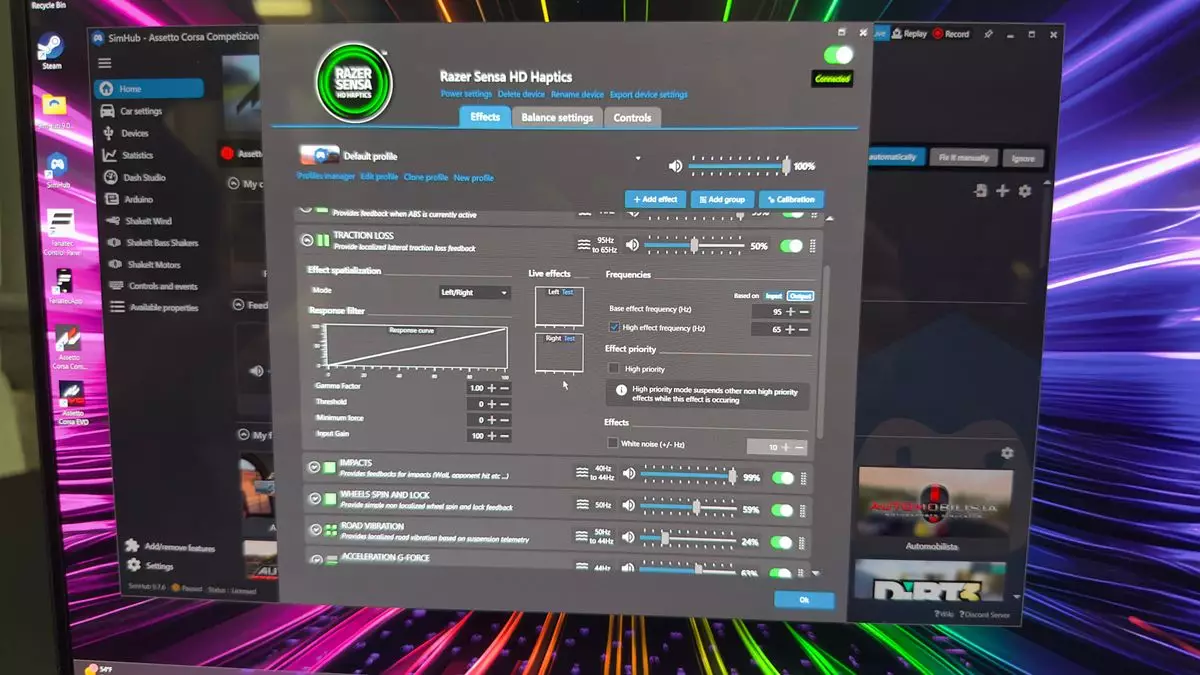Last year marked a bold leap in gaming technology with Razer unveiling two innovative products that placed haptic feedback at their core: the Freyja seat pad and the Kraken V4 Pro headset. The idea of haptic feedback isn’t just about adding some vibrations; it’s about revolutionizing how gamers connect with their virtual experiences. While the Kraken V4 Pro stands out in terms of performance, its hefty price can often deter potential users, turning away those who might benefit from its groundbreaking features. One wonders, however, whether the Freyja’s effectiveness is confined to a select few experiences or whether it has the potential to enrich the entire gaming landscape.
At the recent GDC 2025, my curiosity finally found answers. Experiencing the combination of the Freyja and Kraken V4 Pro headsets while engaged in sim racing opened the door to an entirely new realm of immersion. I slipped into the racing cockpit of a Lamborghini in Assetto Corsa Competizione, equipped with a robust Razer and Fanatec direct-drive setup, and began my simulation journey. Initially, the haptic feedback from the Freyja under my seat felt distracting. But with every passing minute, a transformative connection began to form between the feedback and my gameplay—a connection that many gamers, especially those in the sim racing community, may find exhilarating.
The Connection Between Reality and Virtuality
Sim racing has a dedicated following, and for good reason: it demands precision, skill, and a nuanced understanding of vehicle dynamics. The Freyja seat pad and Kraken V4 Pro headset come alive in this realm, dramatically enriching the experience by allowing players to “feel” the track instead of merely guessing it. As I navigated the nuances of braking and acceleration, the feedback provided by the Freyja added a layer of tactile communication that went beyond mere auditory cues. Suddenly, rather than relying solely on auditory signals or visual cues to gauge traction, I began to feel subtle vibrations that hinted at the car’s behavior.
This powerful sensation wasn’t just an exciting novelty; it was transformational, allowing for heightened accuracy in my driving techniques. Each subtle shift in vibration became a pivotal indicator of understeering or cornering prowess. While it’s clear that the mechanics of acceleration and braking still reside firmly in the realm of physics, the Freyja pad provided a supplementary awareness that enhanced my gameplay, pushing my lap times down like never before.
The Potential for a Complete Racing System
The question that lingers for avid gamers is what comes next. Could Razer expand their haptic technology into a full racing seat, integrating the Freyja features seamlessly? While that specific question remains unanswered—met only with an enigmatic smile and a deflection about unannounced products—one must wonder about the untapped potential of such a system. A full motion-capable racing seat, replete with integrated Freyja technology, could redefine how gamers experience racing simulations, providing an unparalleled level of immersion.
Nevertheless, even if Razer has plans to develop such a product, marketing it to a niche community raises complicated challenges. Sim racing, while fervently followed, constitutes a small segment of the gaming industry overall. Introducing an advanced Freyja racing seat at a price point that does justice to its intricate technology yet remains palatable to consumers presents a significant hurdle. The current Freyja system already occupies a premium space in the market, and adding advanced features could lead to pricing that alienates a broader audience.
Integrating Software for Seamless Gaming Experiences
As part of its announcements at GDC, Razer revealed its efforts to consolidate its software SDKs into a single platform known as Wyvrn. This new integration is expected to work seamlessly with Unreal Engine 5.5, paving the way for developers to harness the full potential of haptic technology in future gaming titles. By providing a streamlined framework for incorporating haptic feedback, Razer is fostering a more engaging experience for players, ultimately setting the stage for a game development evolution that prioritizes player sensation.
Such advancements leave many enthusiasts like me yearning for a fully equipped racing setup at home—a prospect that continues to tantalize. However, one might have to consider the impact of such immersive technology on their home environment, especially with pets like my cats potentially reacting to an office that shakes and vibrates at the rhythm of digital racing.
Razer’s exploration of haptic technology through products like the Freyja seat pad and Kraken V4 Pro headset opens exciting doors within the realm of gaming, blending the physical sensations of simulation with the digital experiences that thrill gamers around the world. By refining this immersive technology, Razer is not just innovating gadgets; they’re reimagining what it means to be a gamer.

